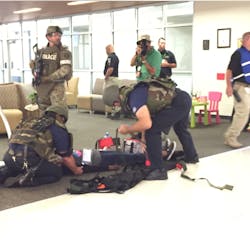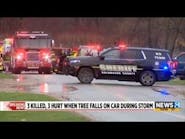Across the country and around the world, we have seen an increase in the number of mass shootings. Most recently and closest to home, the city of Orlando, FL, experienced the largest mass shooting in U.S. history when a single gunman murdered 49 innocent people and wounded dozens more at the Pulse nightclub on June 12, 2016. Much has yet to be shared about Pulse, including the overall fire/EMS response. However, Orange County Fire Rescue responded with 41 field operations personnel in mutual aid support of our brothers and sisters at the Orlando Fire Department.
Prior to the tragic events of that day, this article was in draft. As we began to pick up the pieces and heal as a community, we struggled with how to finish it in light of what happened. After Pulse, it felt like the world had changed. Certainly our reality did that day, and in the days, weeks and months that have followed it. This is our new norm, and that is a sobering realization. As much as we prepare, there is no preparation for the emotional devastation that results from a tragedy of the magnitude experienced in Orlando.
However, the purpose of this article is not a dissection of the Pulse response. It will be discussion of how our department has trained and continues to train today for an active shooter event. It will emphasize what we believe should be an increasingly important mainstay instituted in all departments’ training curriculum.
Statistics prompt changes
Though 2016 data has not been released to date, according to the FBI, 20 active shooter events occurred in both 2014 and 2015. Until the Columbine incident in 1999, these types of incidents were almost always handled by law enforcement, while fire and rescue units staged at a distance in a safe location. Units waited for law enforcement to search and secure the entire scene prior to any fire and rescue personnel entering to begin treating any patients that needed medical care.
- Newly Announced Special Session at Firehouse Expo 2016: "Lessons Learned from the Response to the Pulse Nightclub Incident"
As it became more evident that this is an unacceptable practice to utilize, departments began to develop better ways to get to patients and provide medical care sooner. Orange County Fire Rescue was no different and began to explore training methods that could be implemented during these types of incidents.
These large-scale types of events are typically handled by joint operations between numerous agencies within a jurisdiction. The primary units are usually those from both law enforcement and fire departments as they work cohesively to end the situation and treat the patients as quickly as possible.
In 2013, Orange County Fire Rescue was involved in an incident that stressed the importance of active shooter training. Crews were dispatched to a fire alarm call just after midnight on March 18, but they quickly learned it was much more. The incident involved a student at a local college who planned an attack that he attempted to carry out in the middle of the night. He activated the fire alarm in a dorm building and waited for people to gather in front of the building. The Orange County Sheriff’s Office advised for units to stage in order for the scene to be declared safe. The student’s roommate found him carrying numerous weapons and confronted him. His intention was to then begin shooting the mass number of people gathered in one area. When the suspect attempted to shoot at the roommate, the roommate ran back into his room and blocked the door. The suspect retreated into his room where he shot himself, thus ending the incident in a matter of minutes. But clearly, this was a near miss.
The incident poignantly demonstrated the potential of an active shooter event occurring within our jurisdiction.
Fire, law enforcement join together for training
Shortly thereafter, Orange County Fire Rescue began to work with the Orange County Sheriff’s Office to develop a system that both agencies could utilize in case one of these horrific incidents occurred. During the joint training development, a government grant was obtained that provided funding to establish the foundation needed to train both agencies.
The agencies agreed upon a concept that was developed by Survival Option Service (S.O.S.) which is based out of Burlington, KY. S.O.S. developed a program called Swift Assisted Victim Extraction (S.A.V.E.), which combines law enforcement and fire department personnel into a Rescue Task Force (RTF).
At Orange County Fire Rescue this RTF or S.A.V.E. team consists of four members of law enforcement and three members of the Fire Rescue department. Once the shooter has been contained, captured or neutralized, and an area has been deemed semi-safe to enter (or declared a “warm zone”), the S.A.V.E team is deployed to enter the building and retrieve victims. Very quick basic medical care is provided primarily to control any uncontrolled bleeding with the end goal of quickly getting the patient to definitive care at a trauma facility. Equipment carried by the medical crews is limited to assist with controlling the bleeding and allowing for the ability to move quickly and remove the patient from the dangerous area to a safe location for further medical care. Small, compact and lightweight devices are utilized to move patients outside from the warm zone so they can be moved to the triage, treatment and transport area.
Each member of the S.A.V.E. team also wears a ballistic vest and helmet in case any unforeseen incidents occur while inside the warm zone. The law enforcement aspect of the team has a primary function of providing protection for the medical personnel of the team. The four law enforcement members are not there to pursue suspects or conduct in-depth room-clearing functions, but only to provide protection for the medical crews. This also allows medical crews to feel safe and have the ability to treat and prepare patients to be removed from the building without the need to be on the lookout for any suspects who might try to attack them while their attention is on the patient.
Orange County’s sheriff’s office and fire department worked together while developing the training to ensure both agencies agreed to the overall concept and practices that would be utilized during an active shooter event. Both agencies also realize that an active shooter event will not always play out exactly as it is trained for, so personnel must be willing and able to adapt to any given situation and utilize all or parts of the training.
Continued training builds relationships, sharpens skills
Both Orange County Fire Rescue and Orange County Sheriff’s Office continue to train together on these and other topics on a weekly basis, sometimes up to three days per week. This has helped develop a stronger working environment, familiarity and comfort level between responders, and a solid partnership. We regularly invite other agencies to our trainings as well. Many have joined us including the University of Central Florida Police Department, Florida Highway Patrol, Winter Garden Fire Department and Ocoee Fire Department, just to name a few, to ensure we are training under the same model. With multiple agencies responding during an active shooter event, it makes good sense to ensure that a multi-jurisdictional approach using the same model is in place. Using consistent terminology, tactical approaches and equipment are integral to a cohesive, unified response.
In addition to our S.A.V.E training, we participate in some type of active shooter drill every other month on average. These drills can range from table-top exercises involving a few command staff members to full-scale drills involving numerous suppression units, transport units, command staff and simulated victims.
We continually evaluate how we train and lessons learned from each training experience to ensure we are operating in the safest and most efficient way. The end goal of this concentrated training effort is to both ensure victims receive the medical care they need to survive and ensure first responders are protected in the process.
Of course, there is training and there is operational reality. As hard and as often as we train, we continue to ask ourselves, has the paradigm shift fully occurred in the fire service? Has it occurred for law enforcement? Have we truly evolved to the point where we will execute in real time the model we consider to be best practice? Only time will tell.
However, it is certainly time to ask yourself, your crew, your department and your community partners, what will you do when training meets reality?
- More at Firehouse Expo 2016: Orlando Fire Chief Roderick S. Williams and Orange County Fire Rescue Chief Otto Drozd III will present "Lessons Learned from the Response to the Pulse Nightclub Incident" on Oct. 21. They will discuss how their respective departments' training helped to prepare them for this unexpected tragedy and how the lessons learned from this response highlighted areas of improvement which will guide future training exercises and joint drills.
Jason Perrigo is the battalion chief the Orange County, FL, Fire Rescue's Training Section. He has been in the fire service for over 27 years and his experience includes five years as a tactical medic, 10 years as a flight medic, and five years as a fire/arson investigator while also serving as an ATF Certified Accelerant Detection Canine Handler. Perrigo holds an associate of science degree in fire science, Fire Investigator I and a bachelor’s degree in public safety administration.






